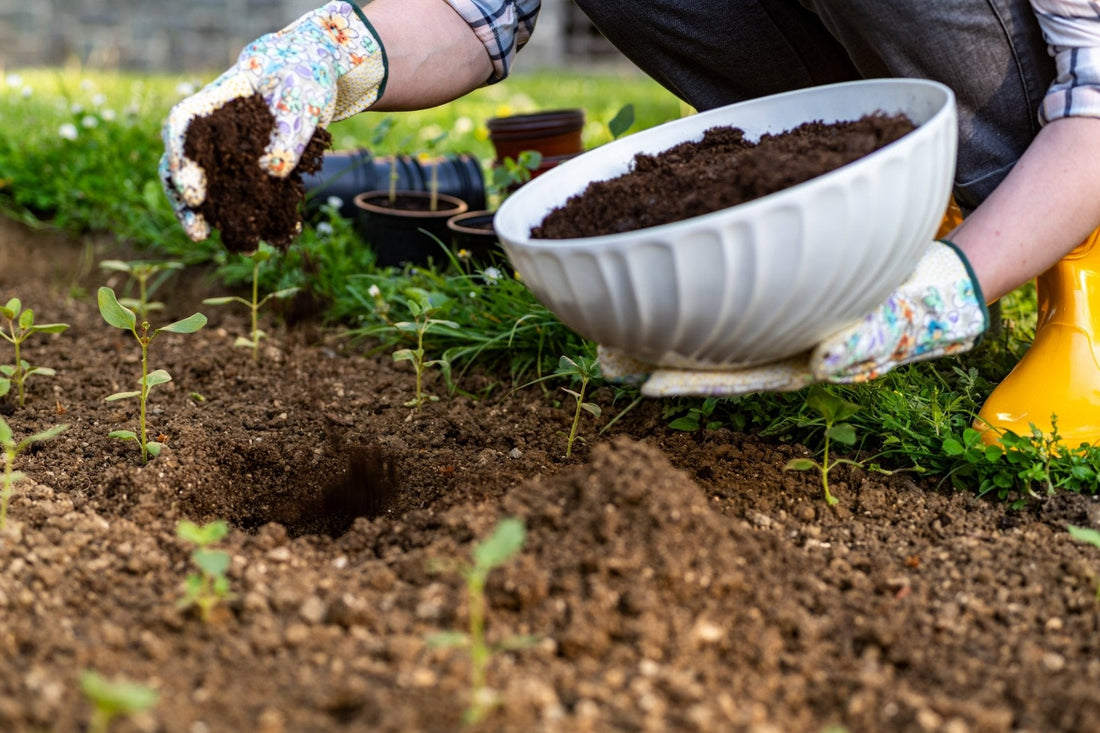Gardening 101: A Down-to-Earth Guide to Different Types of Soil
Ah, soil—the unsung hero of your garden. We walk on it, dig in it, and even grumble about it when things don’t go according to plan. But let’s face it: without the right soil, your garden is like a party without snacks—it just won’t thrive. If you’re gardening in Georgina's growing zone 5, you’re dealing with some unique soil challenges thanks to cold winters and variable growing seasons. So, let’s get dirty and break down the types of soil, why they matter, and what you need to know to get your plants thriving.
So, What Is Soil?
In the simplest terms, soil is the upper layer of earth where plants grow—made up of a delightful mix of minerals, organic matter, gases, liquids, and living organisms. It's like the buffet table at your garden party, offering nutrients, moisture, and a cozy place for roots to hang out. But not all soil is created equal. Your garden might be suffering from a lacklustre guest list if you don’t have the right type for the plants you're growing.

Why Do You Need Different Types of Soil?
Plants are picky. Some want well-drained, sandy soil to let their roots breathe, while others crave dense, nutrient-rich clay that holds onto water for dear life. The type of soil you need depends on what you’re planting and where you're planting it. Here’s a quick rundown of the main soil types:
- Sandy Soil – Light and quick to drain, but often low in nutrients. Think of it as the "fast food" of soil—quick but not always fulfilling.
- Clay Soil – Heavy and nutrient-rich, but doesn’t drain well. It’s like an all-you-can-eat buffet that makes your plants feel bloated if they get too much water.
- Silty Soil – Soft and smooth, with decent drainage and nutrients. It’s the “Goldilocks” of soil—just right for many plants.
- Loamy Soil – The holy grail of soil. It’s a balanced mix of sand, silt, and clay, with plenty of organic matter thrown in for good measure. This is the gourmet meal every plant dreams of.
- Peaty Soil – Acidic and spongy, holding water like a boss. It’s great for moisture-loving plants but tends to be low on nutrients unless you give it a boost.
- Chalky Soil – Alkaline and stony, often leading to nutrient deficiencies. This is for your no-fuss, tougher plants that can handle a bit of a rocky relationship with their soil.
How Do You Know What Soil You Need?
If your plants could talk, they’d probably tell you. But until that day comes, you’ll need to do a bit of detective work. Here’s how to figure out what soil will make your garden sing:
- Test It: No need to guess! Grab a simple soil testing kit to figure out your soil’s pH (whether it's acidic or alkaline), nutrient levels, and texture. Your plants’ roots will thank you.
- Think About Your Plants: What are you growing? Veggies? Perennials? Shrubs? Each plant has a preference for certain soil types. Tomatoes, for example, love loamy soil, while lavender thrives in sandy, well-drained soil.
- Location, Location, Location: Are you planting in a raised bed, a container, or directly into the ground? Your soil choice may vary based on how much drainage you need or what’s already in your garden.

Do You Need to Mix Your Own Soil?
It depends on how much of a control freak you are. Mixing your own soil can give you complete command over your garden’s destiny. You can create custom blends to suit specific plants or conditions, like adding perlite to improve drainage or compost for a nutrient boost. However, most gardeners get by just fine using quality pre-mixed soils, tweaking them with additives as needed.
If you’re the DIY type, here’s a basic mix that works for many plants in zone 5:
- 1/3 Loam
- 1/3 Compost (or other organic material)
- 1/3 Perlite or Sand (for drainage)
Tweak as needed for more specialized plants!
What to Look for When Buying Good Soil
If you’re opting to buy soil, here are some key things to look for:
- Organic Matter – Look for high levels of compost, peat, or other organic materials. This will help with water retention and nutrient levels.
- Texture – Good soil should crumble easily in your hand but also clump together slightly when squeezed. Think “cookie dough,” not “dry sand” or “wet cement.”
- Nutrient Content – If you're buying compost or composted manure, check the bag for nutrient information, specifically nitrogen (N), phosphorus (P), and potassium (K). These are the big three that every plant craves.
- Moisture Retention – Your soil should have a good balance between draining well and holding enough moisture for plants to thrive. You don’t want a swamp, but you also don’t want a desert.
- pH Level – Most plants do well in soil with a pH between 6.0 and 7.0. Check the bag or run a quick pH test.

What to Look Out For When Buying Soil
Not all soil is created equal, and there are some pitfalls to avoid:
- Filler Materials – Beware of soil that feels too light or “fluffy.” It might be packed with cheap filler materials like bark or sawdust, which won’t do your plants any favours.
- Chemical Additives – Some soils are loaded with synthetic fertilizers or chemicals that you may not want in your garden—especially if you’re growing veggies or herbs.
- Weeds or Pests – Always check the soil for signs of contamination with weed seeds, insects, or disease. A bad batch of soil can introduce problems you didn’t bargain for.
- Improper Labelling – Just because a bag says “organic” doesn’t mean it’s perfect. Always double-check the ingredients and nutrient levels.
A Note on Houseplant Soil: Can You Use Outdoor Soil Indoors?
Here’s where things get interesting—houseplants are basically indoor divas that require a different kind of soil than your garden plants. The soil you use in the great outdoors isn't going to cut it inside your cozy home. Here’s why:
Outdoor Soil vs. Houseplant Soil
Outdoor soil is dense and heavy because it’s designed to deal with the elements—rain, wind, snow, and all the fun that comes with the outdoors. While it may work wonders for your garden bed, using it indoors can lead to a few issues, such as poor drainage, compacted soil, and a soggy mess that will suffocate your houseplants.
Why You Need Specialized Houseplant Soil
Houseplants need well-draining, aerated soil that mimics their natural habitat. Houseplant soil mixes are typically lighter and fluffier, often containing components like peat moss, perlite, vermiculite, and sometimes coconut coir. These ingredients help maintain a balance between retaining moisture (because, yes, your plants still need a drink) and ensuring excess water drains away, preventing root rot—a houseplant’s worst nightmare.
Some common types of houseplant soils include:
- Cactus and Succulent Mix: Fast-draining with added sand or perlite, perfect for those sun-loving, drought-tolerant beauties.
- Orchid Mix: A coarse blend of bark, charcoal, and perlite, ideal for epiphytes like orchids that thrive on minimal soil contact.
- General Indoor Potting Mix: A blend of peat, compost, and perlite that works well for most indoor plants.

Can You Use Outdoor Soil Indoors?
In a word—no. At least not without a serious makeover. Outdoor soil is often teeming with microbes, insects, and who-knows-what that can turn your indoor plant paradise into a horror show. Plus, outdoor soil is much too heavy and doesn’t provide the drainage houseplants need. If you’re in a pinch, you could theoretically mix outdoor soil with some perlite or sand, but it’s usually better to just buy a good-quality indoor potting mix designed for houseplants.
Why Soil Is NOT Dirt (And Why Dirt Is Useless)
Before you head out to your garden thinking dirt and soil are one and the same, let’s clear this up: Soil is NOT dirt. The two are not interchangeable, and here’s why.
Soil = Life
Soil is the foundation of all plant growth. It’s teeming with nutrients, organic matter, microorganisms, and all sorts of beneficial bacteria that work together to create a thriving ecosystem for your plants. Soil is like a supercharged environment designed to nurture roots, retain moisture, and allow oxygen to flow. It’s a well-balanced, finely tuned network that supports life.
Dirt = Dead
Dirt, on the other hand, is just lifeless material. Think of it as soil’s lazy, useless cousin. Dirt is what you find on your shoes, in your house, or under your fingernails after a day of gardening—it’s void of nutrients, organic material, and any beneficial life forms. While dirt might give your hands a “natural” look, it won’t give your plants what they need to thrive.
So, there you have it, using dirt in your garden is like serving your plants a diet of cardboard. Without nutrients or structure, it won’t hold water well, won’t feed your plants, and certainly won’t help create the lush garden of your dreams. Soil is your garden’s best friend, and dirt is just something you wash off at the end of the day. Now that you’ve got the dirt (pun intended) on soil, you’re ready to give your plants the environment they need to thrive!
Happy gardening!
Shannon, the Garden Girl
Shannon, the Garden Girl from Georgina Garden Centre, breaks down everything you need to know about soil types and why choosing the right one matters!




